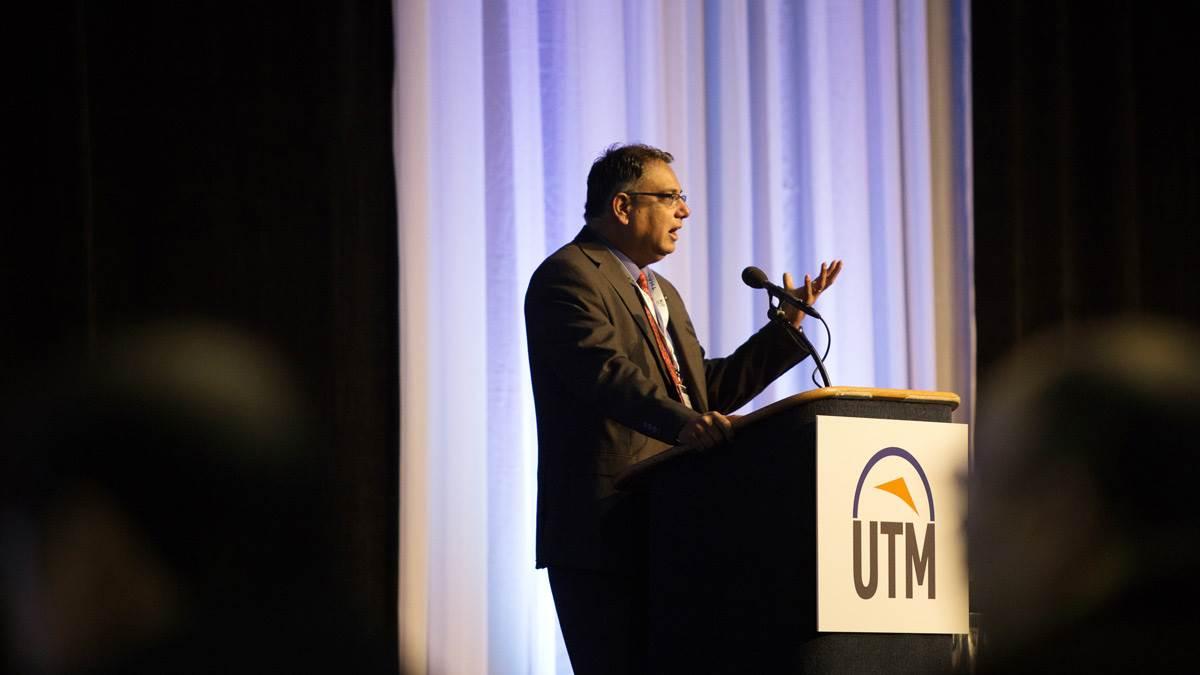Five questions for Parimal Kopardekar
No single scientist has a more central role shaping the integrated airspace of the future than Parimal H. Kopardekar, principal investigator of the NASA UAS Traffic Management program.
Known to industry insiders by his initials and frequently called to speak at drone conferences, P.K. earned his doctorate in industrial engineering in 1995 and has since distinguished himself as one of the world’s leading experts on air transport research, working for the FAA as well as NASA. Kopardekar has been busy as a beaver in recent years overseeing this far-reaching and collaborative drone research effort, but not too busy to field five questions from AOPA Drone Pilot.
One of the elements of UTM architecture and roles is UAS Service Supplier (USS). USS could offer one or more services that are needed to ensure safe and efficient operations for UAS. These services could include 3-D maps, flight planning, weather predictions, track and locate, communications, surveillance, etc. If a region has many heterogeneous operations (manned and unmanned both), it is important to ensure safety of operations for all. Therefore, one of the USS could be surveillance of manned operations that's provided to the UAS operator. The UAS operator could get those services from a USS to maintain safety of operations.
Do you think computers and automation systems will eventually handle disruptions, contingencies, and off-nominal conditions as well as or better than a well-trained and experienced human pilot?
One way to look at this is many UAS operators are interested in the ability to manage "m" number of drones with "n" number of pilots. The values of "m" and "n" need to be determined with research. Many use cases and businesses need to be able operate multiple UAS by one operator, assisted by the automation. Clearly, as the question indicates it's all about being able to manage contingencies and off-nominal conditions in a safe manner. The fundamental research about how to ensure safety and efficiency of operations with human-automation teaming is something many researchers are investigating. As you start to imagine beyond visual line of sight operations, you need to rely on information that's more in electronic form rather than [in sight]. Such beyond visual line of sight operations will have to rely on capabilities such as track-and-locate, detect-and-avoid, obstacle avoidance for last/first 50 feet through input from sensors which will augment human capabilities to manage the operations in all conditions.

What is NUSTAR, when can we expect it, and what will it do for research, and for the industry?
Simplest way to explain National UAS Standardized Testing and Rating (NUSTAR) is it's an underwriter's laboratory for small or medium size UAS. We need to understand the performance of various UAS. These may include tolerance to wind conditions, ability to [operate] under GPS degraded or denied conditions, detect-and-avoid performance, ability to handle off-nominal conditions (e.g., rotor failure). NUSTAR capability will allow us to examine the performance in a standardized manner and assist in determination under which conditions of a particular UAS can be safely operated.
Scientific research almost always produces surprises, results, or phenomena that the investigator did not expect. Have there been many surprises as the UTM Program has grown and developed, and what stands out to you as the most unexpected result, development, or occurrence along the way?
Interesting observations have been uncovered by our team who have been conducting analysis, simulations, and field tests. For example, different types of vehicles (e.g., fixed wing, multi-copter, or hybrid) get impacted by winds in an interesting manner. Some vehicles with low wing-loading [get] bounced around in winds. Such findings have interesting implications on how close we let them operate with each other. Another observation is to be able to use same altitude standard, an approach manned aviation has long adopted.
Was there a particular moment or experience that triggered your interest in drones? Have you ever personally flown a drone? Taken a dronie?
Yes, I have a drone and have registered my drone and fly drones. I started conducting my Ph.D. research on airspace operations and air traffic management (ATM) research in 1993. I got fascinated with that topic after listening to a talk on ATM in one of the conferences. I then worked for a FAA contractor, subsequently was hired by the FAA, and then was hired by NASA in 2002. I have conducted research and development activities to increase the capacity and efficiency, and to reduce delays in the current air traffic management system. In early 2013, I began to think about future needs and speculated that there will be a need for a UAS Traffic Management system. I began the research and it grew in its importance after industry and FAA actively started supporting the UTM construct. Now, many other countries are following the UTM concept. We have a very good and motivated team that's focused on UTM and it is a great example of collaborative innovation that leverages government and industry ideas.
AOPA Drone Pilot is a free, biweekly newsletter created for anyone with interest in drone technology, training and safety, policy, and industry news. Sign up now to receive the next issue; you may unsubscribe at any time.



